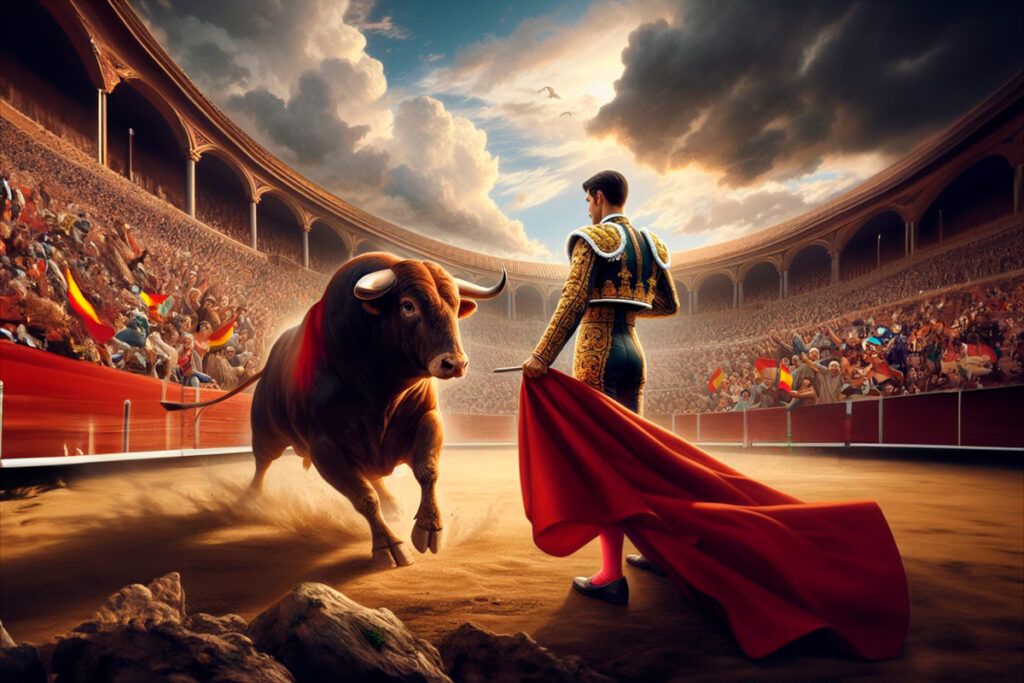Spanish bullfighting – tradition or torture?
Spanish bullfighting, also known as corrida, is one of the most controversial and exciting spectacles in the world. For many Spaniards, it is not just a form of entertainment, but also a symbol of national pride and culture. For others, it is a cruel and inhumane killing of animals, which should be banned and condemned. In this article, we will try to bring closer the history, significance, and arguments for and against this ancient tradition.
History of the corrida
The history of the corrida goes deep into the past and is inextricably linked with the history of Spain. Some argue that its origin dates back to Roman times when gladiators fought wild animals in arenas. Others point to the Arab influence, which brought to the Iberian Peninsula the custom of hunting bulls on horseback. Still others cite the Celtic and Iberian cultures, which revered the bull as a sacred and sacrificial animal, as the source of the corrida.
The first written testimonies of the corrida date from the 12th century when a bullfight was organized in honor of King Alfonso VIII in Valladolid. Since then, the corrida has gained popularity among the Spanish nobility and aristocracy, who treated it as a sport and a display of courage. In the 18th century, the corrida became a more organized and formal spectacle, with established rules and stages. The first bullfighting arenas, known as plazas de toros, were created, as well as a special costume and accessories for matadors. In the 19th century, the corrida reached the peak of its fame and became a national symbol of Spain. Its culture was promoted by famous writers, artists, and politicians. Matadors, such as Juan Belmonte and Manolete, became true heroes and idols of the people.
In the 20th century, the corrida began to encounter increasing resistance and criticism from animal rights movements, environmental organizations, and parts of society. It was accused of being a cruel and barbaric practice that has no place in a civilized world. In some regions of Spain, such as Catalonia or the Balearic Islands, the corrida has been banned or restricted. However, in many other places, it is still legal and enjoys considerable interest and support.
The significance of the corrida
For its supporters, the corrida is not only a spectacle, but also an art, a ritual, and a metaphor; it is an expression of Spanish culture, tradition, and identity. The corrida has its own aesthetics, symbolism, and ethics.
For the matador, the corrida is a challenge and a test. He must demonstrate courage, skill, and elegance in confrontation with a powerful and dangerous animal. He must also respect the bull and treat it as a worthy opponent, not as a victim. The matador becomes a hero if he can kill the bull with one precise and clean thrust of the sword into the heart. Then he receives a reward in the form of the bull’s ear, tail, or both, as well as a standing ovation and a lap of honor around the arena. However, if he makes a mistake or proves incompetent, he may be injured or killed by the bull, or booed and ridiculed by the audience.
For the bull, the corrida is a fight for life and death. The bull is specially bred and prepared for the corrida to achieve the appropriate weight, strength, and temperament. The bull is treated as a noble and proud animal, which does not easily give up and resists. The bull is also a symbol of nature, wildness, and freedom, which contrast with human culture, civilization, and limitations. The bull has a chance of survival if it proves exceptionally brave, intelligent, and rebellious. Then it can be pardoned by the matador and the audience, and also receive the honorary title of indulto. Such a bull is then used for breeding and ensuring better quality offspring.
For the audience, the corrida is an exciting and passionate spectacle. The audience actively participates in the corrida, expressing their reactions, opinions, and feelings. The audience can admire, support, criticize, or reject both the matador and the bull. The audience can also demand or oppose the pardoning of the bull, the reward for the matador, or the end of the fight. The audience is also a witness to the drama and tragedy that unfold in the arena and experiences strong emotions, such as admiration, tension, fear, compassion, joy, or sadness.
Arguments for and against the corrida
The corrida is a topic that provokes many discussions and disputes. There are various arguments for and against this tradition, which can be divided into several categories: cultural, ethical, economic, and ecological.
Cultural arguments concern the significance and value of the corrida as part of Spanish heritage and identity. Supporters of the corrida argue that it is a unique and unparalleled form of art and culture, rooted in the history and tradition of Spain. The corrida is also a source of pride and prestige for Spaniards who feel connected to and identify with it. The corrida is also an expression of freedom and democracy, as everyone has the right to participate in, watch, and express their opinion about it. Banning the corrida would be a violation of the rights and freedoms of Spaniards, as well as a loss and destruction of their culture.
Opponents of the corrida argue that it is an outdated and barbaric practice that has no place in a modern and civilized society. The corrida is also a source of shame and disgrace for Spaniards who do not feel connected to it and identify with other values and ideals. The corrida is also a violation of the rights and dignity of animals, which are subjected to unnecessary suffering and death for the entertainment of people. Banning the corrida would be an act of humanitarianism and progress, as well as respect for life and the environment.
Ethical arguments concern the morality and humanitarianism of the corrida as a form of treatment of animals. Supporters of the corrida argue that bulls used for the corrida are treated with respect and dignity, both before and during the fight. Bulls are specially bred and fed to achieve optimal condition and strength. Bulls are also chosen for their courage and temperament, making them worthy opponents for matadors. Bulls also have a chance to defend and escape, and even to be pardoned, if they show exceptional traits. Bulls are also killed in a quick and honorable way, and their meat is used for food purposes.
Opponents of the corrida argue that bulls used for the corrida are treated with cruelty and contempt, both before and during the fight. Bulls are subjected to stress and pain to weaken their resistance and facilitate the task for matadors. Bulls are also exposed to numerous wounds and bleeding, caused by the lance, banderilles, and sword. Bulls have no chance to defend and escape, and their pardon is very rare and dependent on the whim of people. Bulls are also killed in a brutal and humiliating way, and their bodies are often mutilated and discarded.
Economic arguments concern the benefits and financial losses associated with the corrida as an economic activity. Supporters of the corrida argue that it is a source of income and employment for many people, both directly and indirectly. The corrida generates revenues from tickets, advertisements, television broadcasts, souvenir sales, and other services. The corrida also creates jobs for matadors, banderilleros, picadors, veterinarians, bull breeders, arena workers, and others. The corrida also attracts tourists and investors, which increases the attractiveness and prestige of the regions where it takes place.
Opponents of the corrida argue that it is a waste of money and resources that could be better used for other purposes. The corrida absorbs large sums from public budgets, which are allocated to the maintenance and subsidizing of arenas, bull breeding, organization of fights, and others. The corrida also burdens the healthcare system, which has to deal with the victims and consequences of fights, both human and animal. The corrida also deters tourists and investors who disagree with its practice and ethics.
Ecological arguments concern the impact of the corrida on the environment and biodiversity. Supporters of the corrida argue that it is a form of protection and preservation of the Spanish bull species, which is unique and endangered. The Spanish bull is bred in a natural and ecological way, without the use of hormones, antibiotics, and other substances. The Spanish bull is also part of the landscape and ecosystem of Spain, which provides balance and diversity. The Spanish bull is also a heritage and genetic wealth, which should be protected and admired.
Opponents of the corrida argue that it is a form of exploitation and degradation of the Spanish bull species, which is unnatural and artificial. The Spanish bull is the result of selection and genetic manipulation, aimed at obtaining traits desired by people, not by nature. The Spanish bull is also a source of pollution and emissions, which harm the environment and climate.
The corrida is a phenomenon that arouses many emotions and opinions. Some consider it an art and tradition, others cruelty and barbarism. Some see benefits and values in it, others losses and damages. Some want to preserve and admire it, others ban and forget it. The corrida is a symbol and problem of Spain, which does not have an easy and clear solution. And what is your opinion? You can express your opinion by commenting on this article.

